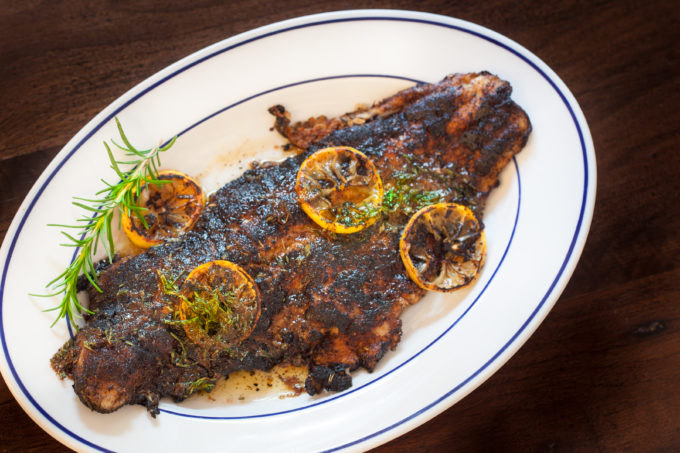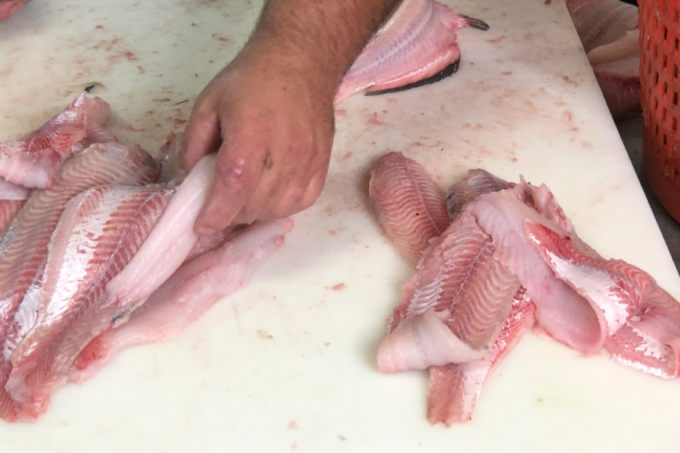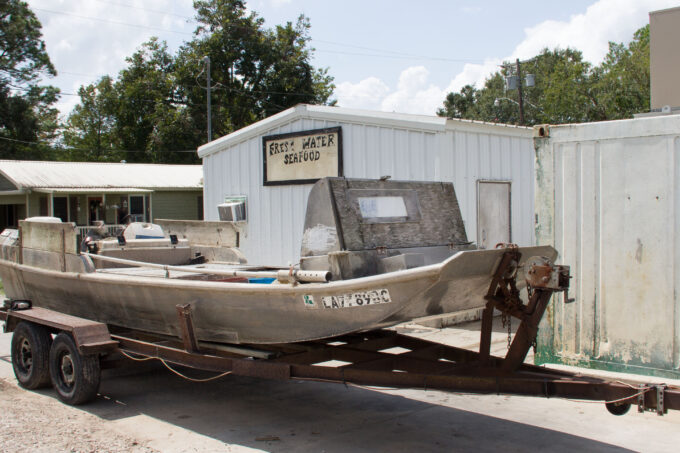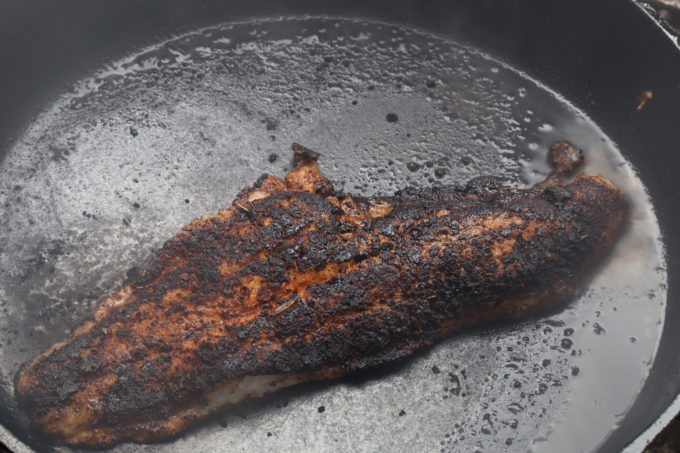Rich and savory with butter and spices, the first bite of my Blackened Catfish with Lemon Rosemary Sauce will shift your taste buds into overdrive. The browned butter develops an almost nutty taste that balances with the herbs and spices infused with white wine. And if you follow our step-by-step video in this story, it’s easy.

Blackened catfish is a classic Cajun recipe. (Photo credit: George Graham)
This recipe comes from my newest cookbook, Fresh From Louisiana: The Soul of Cajun and Creole Home Cooking. Published by Harvard Common Press, this is my second in a series of books focused on the food of Louisiana.

With over 100 recipes and full-color photos, this cookbook focuses on the seasons of Louisiana. Click through to order your autographed copy. (Photo credit: George Graham)
This book goes even deeper into the culture and peels back the layers of culinary mystery and history that make our cuisine so unique. And it focuses on seasonal fresh ingredients that are the cornerstone of Louisiana cooking.

Wild-caught catfish fillets. (Photo credit: George Graham)
An essential fresh ingredient in this recipe is top quality catfish. And to ensure I get the best, I go wild–wild-caught catfish, to be specific. There is a difference in how your catfish are brought to market, and to fully understand why, we made a trip to the source: Butch Smith at Fresh Water Seafood in Loreauville, LA. Butch is referred to as the “King of Catfish” in these parts, and after meeting him, I can understand why.
According to Butch, wild-caught (think: free-range) catfish are caught in hoop nets in the freshwater lakes and rivers of Louisiana, whereas pond-raised catfish are a product of an aquaculture industry that mass-produces the fish and floods the market with an inferior product. The taste and texture of wild catfish is cleaner, sweeter, and holds up to various cooking techniques like grilling or blackening. It’s just a better product.

With their catch on ice, boats pull up in front of the processing facility. (Photo credit: George Graham)
At Fresh Water Seafood, a catch of over 8000 pounds on a good day is cut, gutted, skinned, and filleted by a highly skilled crew at his USDA-certified plant. It’s big business, and Butch is the biggest. His company is the largest wild catfish processor in the state, serving a growing wholesale, restaurant, and retail consumer market. If you want to learn more, take a look at our video where Roxanne, Lo, and I went behind the scenes at Fresh Water Seafood’s processing plant and talked to fillet-master Colby Thibodeaux in the room where it happens.
Click on this short video and watch as George, Roxanne, and Lo show you how to blacken wild-caught catfish.
Time to blacken. The culinary technique of blackening is one of those mysterious recipes that has become synonymous with Louisiana cooking. It is one of my favorite methods for cooking fish of any kind–especially catfish. With the deep, dark flavor of pungent spices that seal in the moist flesh of wild-caught catfish, it’s cloaked in a lemony butter sauce that zings with taste. I love it so.

Six simple ingredients for my Blackened Catfish. (Photo credit: George Graham)

Coat with the spice rub to get the perfect char for a properly blackened catfish. (Photo credit: George Graham)

Blackened catfish cooked outdoors in a cast-iron skillet is the only way to go. (Photo credit: George Graham)
If you want to source Fresh Water Seafood’s wild-caught catfish, the folks at Louisiana Direct Seafood have made it easy. Now you can order Vermilion Bay Sweet catfish online at the Louisiana Direct Seafood SHOP.

Wild-caught catfish is available for shipping nationwide on the Louisiana Direct Seafood website. (photo credit: Caleb Dunlap)
Flash frozen and vacuum-packed, Louisiana wild-caught catfish fillets are available in approximately one-pound packs. Buy your Louisiana wild-caught catfish direct from the fisherman or have it shipped directly to you; either way, you will be amazed at the quality difference that wild catfish will bring to your table.
- 3 tablespoons smoked paprika
- 1 teaspoon Worcestershire powder
- 1 teaspoon cayenne pepper
- 1 teaspoon white pepper
- 1 teaspoon lemon pepper
- 1 teaspoon garlic powder
- 1 teaspoon onion powder
- 1 teaspoon dried rosemary
- 1 teaspoon dried thyme
- 1 teaspoon dried oregano
- 1 teaspoon salt
- 1 teaspoon ground black pepper
- ½ cup melted unsalted butter
- 4 large (6 to 8 ounces each) catfish fillets, preferably wild-caught
- 8 (1 tablespoon each) pats of unsalted butter
- 4 tablespoons freshly squeezed lemon juice
- ½ cup dry white wine
- 2 tablespoons chopped fresh rosemary
- 8 lemon slices
- 4 sprigs of fresh rosemary
- Add all of the ingredients to a food processor and blend. Pour into an airtight container and store at room temperature for up to 6 months.
- On an outdoor gas grill or propane (or butane) burner, preheat a seasoned cast-iron skillet until very hot (this will take about 10 minutes).
- Brush both sides of the fillets with melted butter and coat with blackening seasoning.
- Add 2 pats of butter to the skillet and let melt. Using a large spatula, add a catfish fillet to the hot skillet and let cook on the first side for 1 minute (or a bit longer if your fillet is thicker) without moving. Gently turn the fish over and cook on the other side until done, about 1 minute, and remove to a platter to keep warm. Wipe the skillet clean and repeat until all the fish is cooked.
- Lower the heat on the skillet and add the wine, lemon juice, and fresh rosemary along with the lemon slices. Bring to a simmer and reduce the wine by half, about 5 minutes.
- For serving, add a blackened catfish fillet to a plate and spoon over the sauce along with 2 of the lemon slices. Garnish with a fresh rosemary sprig.
This Boat-To-Table series of stories, recipes, and information about our seafood industry is brought to you in support of Louisiana Direct Seafood, a free program of Louisiana Sea Grant and LSU Ag Center.

Spiced, seared, and sauced to perfection–tasty Blackened Catfish. (Photo credit: George Graham)
YOUR SEAT AT THE TABLE: If you like this Cajun cooking story and Cajun recipe then accept my personal invitation to subscribe by entering your email at the bottom or top right of this page. It’s quick and painless. You will receive an email alert and be the first to see when new Cajun cooking stories and Cajun recipes are added. Thanks, George.
Hey Travis-
And tasting mighty good as well. Be sure to fire up the (outdoor) burner and blacken some catfish soon. Thanks for the comment.
Hey Tracy-
And it’s easy, too, if you have an outdoor burner and a cast iron skillet–two essentials for a perfect outcome (and no fire department). Let us know how yours comes out.
Rick-
You are correct in Chef Paul’s disclaimer, and he has a similar one on his online recipe. And yes, it is worth it. Thanks for sharing your experience.
Hey John-Christopber,
What a great tip, and you are correct. If you continue cooking in the skillet, you will build up burnt bits and pieces. Big difference between blackened and burnt–thanks for catching that, and I will add it to the instructions. It’s input from readers like you that make these recipes even better. Thanks.
Hey Terry-
Very interesting historical perspective. It is apparent that both his recipe and his weight evolved over time. Chef Paul was a culinary genius, and he was not afraid to change his techniques over time. Layering of spice and flavor is his greatest lesson for cooks, and is at the heart of my philosophy of cooking. Thanks for the insight and information.
Could you help with keeping stuffing moist on stuffed artichokes?
Hey Jerry – Olive oil is the key. Make your stuffing mixture with a healthy pour of extra virgin olive oil, and your stuffing will stay moist (and tasty) throughout the cooking. All the best.